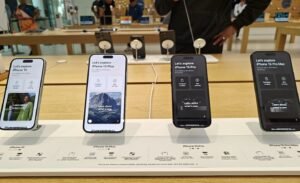
Apple faces stiff competition from Huawei
Apple experienced a sharp decline in iPhone sales within China in the first quarter of this year, mainly due to stiff competition from the country’s tech giant Huawei, according to a recent report by Counterpoint Research.
Sales figures show a decline for Apple and an increase for Huawei
According to data from Counterpoint, Apple saw iPhone sales drop 19.1% in the first three months of the year. In contrast, Huawei, which is headquartered in Shenzhen, China, saw an impressive 69.7% increase in smartphone sales over the same period. This improvement is largely due to the successful launch of Huawei’s Mate 60, which features a state-of-the-art chip that supports advanced 5G connectivity.
Huawei was sanctioned in the US. in 2019, restricting access to critical technology and nearly collapsing the smartphone industry. But Huawei has made a spectacular comeback, emerging as China’s fourth-largest smartphone maker, as noted in a recent survey by Counterpoint.
Apple’s answer is hope for the future
“Apple’s sales were subdued during the quarter as Huawei’s comeback has directly impacted Apple in the premium segment,” Ivan Lam, senior research analyst for Counterpoint Research, said in statement. Lam suggested that Apple should revived in China with new color options, though aggressive funding cuts, new AI for at the upcoming Worldwide Developers Conference (WWDC) in June -“That has the potential to move the needle significantly longer term,” he said.
Counterpoint forecasted a modest year-on-year growth of China’s smartphone market in 2024, with a focus on AI-driven features expected to fuel demand for new devices. Chinese smartphone manufacturers like Xiaomi, Oppo, and Huawei’s spinoff brand, Honor, are integrating advanced AI technologies into their flagship phones, paving the way for future innovations in mid-priced models.
In summary, while Apple faces challenges from Huawei’s resurgence in China’s smartphone market, strategic measures and technological innovations could potentially drive Apple’s recovery and reshape the industry landscape.